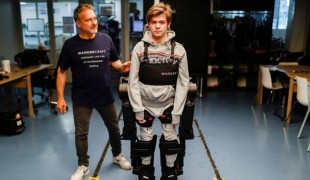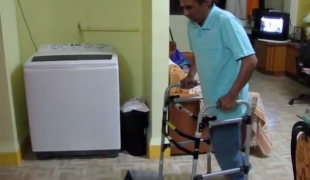- 10151
- 633
- 9
- 9
- 1
- Help Ukraine
About the solution
In the winter of 2006, Hanzhen Ke’s 78-year-old father suffered from cerebral thrombosis, resulting in paralysis of the left side body and leaving bed ridden ever since. After that, Ke’s several brothers took care of him in shifts. Since Ke’s father weighted around 150 kilos, it was a problem helping him lay down, getting him out of bed and feeding him.
Hanzhen Ke is a marine engineer with an extensive experience in hull design and engineering. Faced with his father's pain, and in order to alleviate the physical burden of his brothers, Ke was determined to invent a bed that could save some of the caregiver’s physical strength and bring more convenience to his father. In his spare time, he bought wood and applied the drawing knowledge he learned in shipbuilding school, and in February 2007, after a lot of experiments, the first hand-cranked wood bed was born.
However, Ke was not satisfied, as he considered the wooden bed to be fragile and less practical. He continued his research and development and upgraded the wooden structure into a steel structure, improving the manual turning function into electric using an adequate motor, which he experimented several versions before finding a satisfying one. After developing 4 versions, Ke finally completed the preliminary structure of the "turning bed" in June 2008.
“The turning bed can hold a patient with body weight of as much as 200 kgs”, said Ke. The turning bed can be controlled by a patient or caregiver using the remote, and can be programmed to help the patient, turning the body regularly. The bed can be partly folded and is equipped with 4 wheels to use as a wheelchair to move the patient. A special network is placed above the mattress and enables air to flow below the patients’ body when required. When the mattress is removed, the patient can also take a bath by using the device placed under the bed with no need to move the patient. Besides, the turning bed is also equipped with lamp, table, hanging rack, pillows, fitness stand, etc.
Ke’s innovation has greatly facilitated the life of the family and he also shared his solutions with a few other families. Besides, the turning bed was granted a patent in 2009 and was also highly commented by healthcare specialists because of the innovative functions. Ke believes that the turning bed can be applied extensively in nursing homes for the elderly and by families with bed-ridden elders. He sincerely wishes he would be able to collaborate with companies in order to improve the model and produce more to help the patients in need and relieve the burden of caregivers.
Adapted from: http://bit.ly/2F287oU
This solution shall not include mention to the use of drugs, chemicals or biologicals (including food); invasive devices; offensive, commercial or inherently dangerous content. This solution was not medically validated. Proceed with caution! If you have any doubts, please consult with a health professional.
DISCLAIMER: This story was written by someone who is not the author of the solution, therefore please be advised that, although it was written with the utmost respect for the innovation and the innovator, there can be some incorrect statements. If you find any errors please contact the patient Innovation team via info@patient-innovation.com
-
-
398
-
0
-
5525

Father creates exoskeleton to help son with genetic neurological condition walk
BODY BALANCE: Maintaining body balance
STANDING UP: Standing up from a seated position
WALKING WITH A WALKING AID: Walking with a walking aid
CAREGIVING
Cervical spinal cord injury/Tetraplegia
Assistive Technology access
Walking Aid (wheelchair/walker/crutches)
Restoring mobility
Managing pain
Promoting self-management
Preserving Organ Function
Managing Neurological Disorders
Recovering from Traumatic Injuries
Maintaining Balance and Mobility
Restoring Blood Circulation
To improve Treatment/Therapy
Preventing (Vaccination, Protection, Falls, Research/Mapping)
Raise awareness
Caregiving Support
General and Family Medicine
Intensive Care Medicine
Neurology
Physical Medicine and Rehabilitation
Sports Medicine
France
-
-
-
338
-
0
-
4177

Collaborator Pierluigi Mantovani creates Evolution Devices - solutions that aim to transform Multiple Sclerosis Management
CAREGIVING
BODY BALANCE: Maintaining body balance
STANDING UP: Standing up from a seated position
WALKING: Walking
Multiple Sclerosis
Assistive Daily Life Device (to help ADL)
Walking Aid (wheelchair/walker/crutches)
App (Including when connected with wearable)
AI algorithm
Body-Worn solutions (Clothing, accessories, shoes, sensors...)
Restoring mobility
Regaining sensory function
Managing pain
Promoting self-management
Preserving Organ Function
Managing Neurological Disorders
Maintaining Balance and Mobility
To improve Treatment/Therapy
Preventing (Vaccination, Protection, Falls, Research/Mapping)
Raise awareness
Caregiving Support
General and Family Medicine
Internal Medicine
Medical Genetics
Neurology
Physical Medicine and Rehabilitation
United States
-
-
-
539
-
0
-
11100

Designer creates staircase illusion for her uncle
WALKING: Walking
BODY BALANCE: Maintaining body balance
CAREGIVING
Parkinson's Disease
Muscle Tone Abnormalities weakness
Assistive Daily Life Device (to help ADL)
Strategy/Tip
Gait abnormalities (e.g., walking difficulties, unsteady gait)
Tremors
Muscle cramps or spasms
Difficulty coordinating movements
Stiffness or rigidity (difficulty moving)
Muscle weakness
Loss of balance
Memory loss
Managing Neurological Disorders
Maintaining Balance and Mobility
Preventing (Vaccination, Protection, Falls, Research/Mapping)
Caregiving Support
General and Family Medicine
Neurology
Netherlands
-
 en
en
Ümit Uz • Thu, 09/12/2019 - 07:08
Patient beds are one of the indispensable medical equipment for inpatients. A hasta yatağı must be purchased for a better care environment.